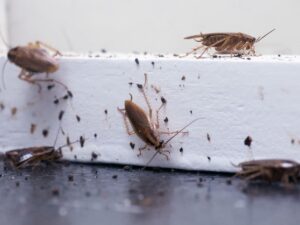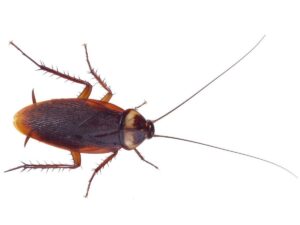Get Rid of Cockroaches
Prices from £135 +VAT for x2 visits
To get rid of cockroaches from your home or business premises call 0800 026 0308

Guarantee
We only guarantee cockroach treatments in detached buildings that have been treated in their entirety.
- In flats, terraced houses and multi-occupancy buildings cockroaches may spread from adjoining premises.
 Cockroaches thrive in warm conditions so they’re mostly found in kitchens, laundry rooms, bathrooms and airing cupboards. They are nocturnal, hiding away during the day in cracks and crevices, behind tiles, notice boards and panels, in dark corners inside drawers and cupboards, inside electrical equipment such as fridges, junction boxes, light fittings etc. If you see cockroaches frequently during the day then the infestation is usually quite serious.
Cockroaches thrive in warm conditions so they’re mostly found in kitchens, laundry rooms, bathrooms and airing cupboards. They are nocturnal, hiding away during the day in cracks and crevices, behind tiles, notice boards and panels, in dark corners inside drawers and cupboards, inside electrical equipment such as fridges, junction boxes, light fittings etc. If you see cockroaches frequently during the day then the infestation is usually quite serious.
Why is it necessary to treat cockroaches quickly?
- Cockroaches are a health hazard as they’re known to carry at least 40 different types of bacteria, including typhoid fever, cholera, dysentery, E. coli and salmonella.
- If cockroaches are left without treatment their numbers will increase exponentially as a female can lay up to 120 to 240 eggs every two months, and there is a short development period from hatching to maturity.
- Cockroaches move quickly and climb with ease on both smooth and rough surfaces and are able to move vertically, up, down, and even upside-down.
Preparation you must undertake prior to treatment
- Ensure kitchen worktops, under the cooker and kitchen cabinets are clean and free from crumbs and grease.
- Clean and degrease under, inside and outside cookers, fridges, etc.
- Empty cupboards and drawers and clean them, inside and outside.
- Vacuum carpets and wash floors.
- Contact neighbours or any building connected to yours to see if they have a cockroach problem.
- Remove any food that is left out, including pet food.
- Ensure cutlery, food, clothes, towels, toothbrushes etc are covered.
Aftercare
- If you get gel bait on your skin wash it off immediately.
- Keep food covered if it is left out.
- Keep the floor under floor-standing equipment clean.
- Be prepared to see dead cockroaches for a few weeks after each treatment. Remove these to the outside bin for disposal.
How our treatment works
Our technician will apply a gel bait treatment. For a particularly heavy infestation, or an infestation spreading from neighbouring properties, more than one treatment will be needed. In shared, communal or multi-occupancy buildings it may be necessary to bait monthly until the infestation is eradicated.
Dead cockroaches will be seen for a few weeks after each treatment.
On our second visit the technician will supply you with cockroach monitoring traps to see if there are any cockroaches left or if a new infestation has occurred. These are harmless sticky traps with pheromone bait and are for monitoring only.
Products we use
The technician will state which product has been used on the report they give you after they have completed the treatment. Click the product to access its safety data sheet.
Bait
Cockroaches in commercial situations
Cockroaches are a common pest in commercial premises which produce, process or handle food such as food and beverage manufacturers and all their suppliers, restaurants, hotels, retail stores, pharmaceutical companies, organisations providing care such as hospitals, nursing homes and schools. Infestations of cockroaches can result in low hygiene ratings from health inspectors because they threaten customers’ safety.
Cockroaches access buildings in a number of ways – in laundry, on raw materials, in crates and packaging or via drains or rubbish chutes – and it’s difficult to prevent continued access. As a consequence it’s necessary to spray or bait the building monthly as an Environmental Health Officer could close it down.
Facts about cockroaches
 Cockroaches are one of the oldest insects on the earth, dating back 320-million years. They are scavengers and omnivores and will eat anything to ensure their survival although they prefer sweets, meat and starches. If their food source is small or the colony has expanded more than the food can sustain then cockroaches will turn to eating their own dead.
Cockroaches are one of the oldest insects on the earth, dating back 320-million years. They are scavengers and omnivores and will eat anything to ensure their survival although they prefer sweets, meat and starches. If their food source is small or the colony has expanded more than the food can sustain then cockroaches will turn to eating their own dead.
Cockroaches crawl very fast and can travel up to 3-miles a day. Although they have 2-sets of wings they can’t fly very well. They can squeeze their bodies through a gap 25% of their own height as they have a flexible exoskeleton and can splay their legs out. They can survive without a head as they breathe through little holes in their body segments rather that their head or mouth and they have an open circulatory system. They eventually die because with no mouth, they can’t drink water and will die of dehydration. A cockroach can hold its breath for up to 40-minutes and can even survive being submerged under water for up to half an hour.
